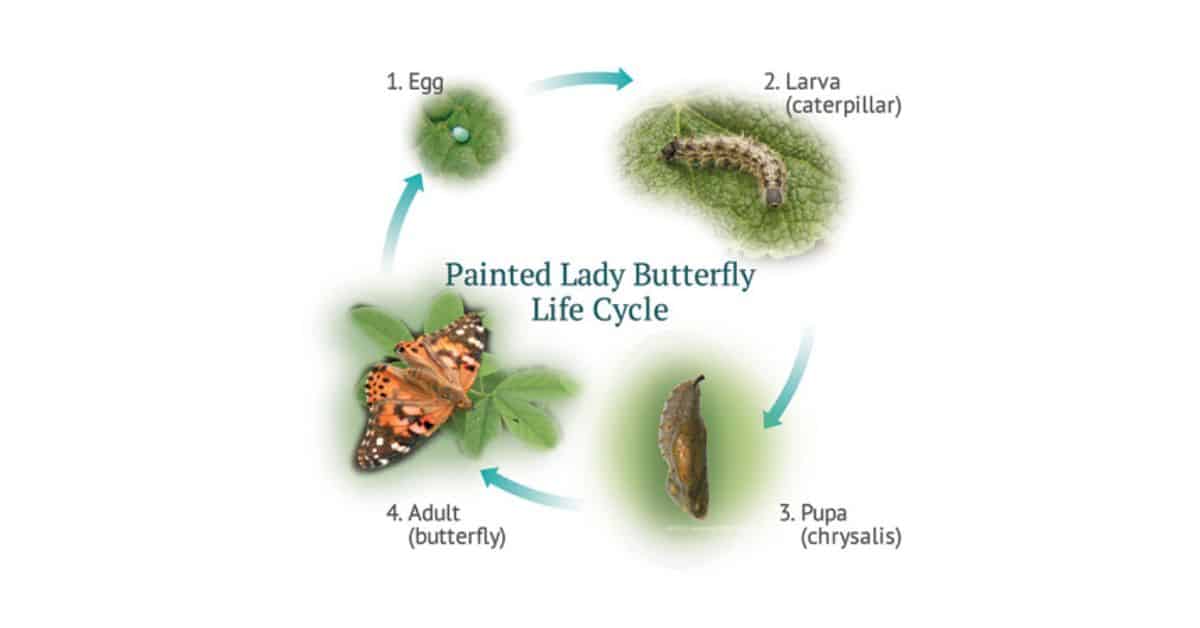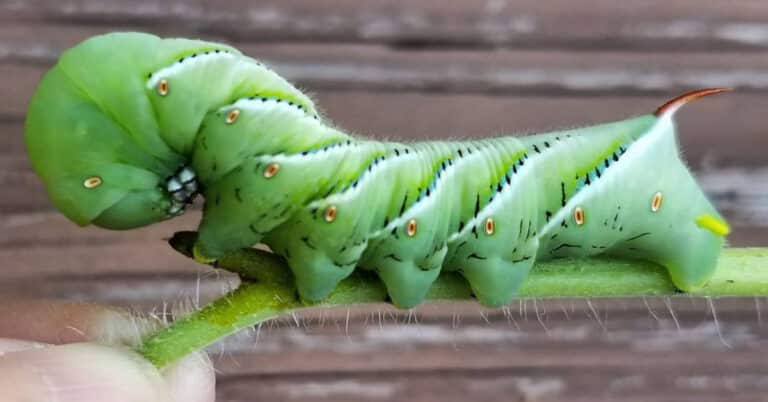Caterpillar Life Cycle – Common Habits & Stages of Development
Caterpillars are some of the most bizarre-looking creatures on earth, famous for their remarkable transformation into butterflies or moths. But what is your knowledge about these amazing creatures and the caterpillar life cycle?
Exploring the developmental stages of the caterpillar life cycle is one of the ways to understand more about our amazing nature. Caterpillars are a type of butterfly or moth larva that looks like worms and is frequently vividly colored, hairy, and warm-looking. However, without knowing the species, it is incredibly difficult to predict whether a caterpillar will become a moth or a butterfly in the future.
In this article, we will go into greater detail regarding the caterpillar life cycle, development, and metamorphosis.
4 Stages of Caterpillar Life Cycle
The metamorphosis process is how the butterfly and moth grow. The Greek term “metamorphosis” translates as a transformation or physical change. There are four phases in the entire metamorphosis process for butterflies and moths: the egg, the larva, also referred to as a caterpillar, the pupa, and the adult stages.
- Egg Stage
The egg stage is the first stage where the caterpillar life cycle starts. On plants, the mature female butterfly lays her eggs. Inside these tiny eggs, caterpillars grow. Depending on the species, the eggs can vary in shape and texture. The time it takes for the eggs to hatch can also vary depending on the species.
The caterpillar grows quickly during this period and plays an important role in the whole cycle. However, the appearance and function of the caterpillar and the adult in Lepidoptera typically differ significantly.
In the beginning, the eggs hatch into a very small caterpillar. Most caterpillars eat eggshells as their first meal. During the process, the caterpillar will multiply its body mass thousands of times before starting to pupate.
- Feeding Stage
Why is the caterpillar life cycle important? The caterpillar’s job is to continuously consume food and grow. As mentioned before, the caterpillar splits its skin as it grows and sheds it around four or five times. Interestingly, the food consumed at this age is saved for use as an adult.
During this stage, caterpillars can expand 100 times their original size. A monarch butterfly egg, for instance, is about the size of a pinhead, and the caterpillar it produces isn’t much larger. But after a few weeks, it will reach a maximum length of 2 inches.
Different butterfly species have different numbers of instars. In its fifth instar, the caterpillar will soon pupate, or molt, one more time to become a chrysalis. Depending on the species and the development circumstances, the butterfly spends a total of 2 to 5 weeks as a caterpillar.
Given the high mortality rates, it is thought that the caterpillar stage of a butterfly’s life cycle is the most hazardous. Weather, illness, parasites, and predators can all affect caterpillars. Only a small percentage of the hundreds of eggs laid by many adult butterfly species develop into butterflies.
- Transition Stage
Another stage of the caterpillar life cycle is turning into a pupa. Usually, this happens when it has reached adulthood and stopped eating. The pupa may be buried underground, concealed in leaves, or hanging under a branch, depending on the species. Many moth pupae are enclosed in a silk cocoon for protection.
Although it may appear that nothing is happening, internal adjustments are taking place. In the larva, special cells were present, and they are currently dividing quickly. They will develop into the adult butterfly’s legs, wings, eyes, and other features.
- From Caterpillar To Butterfly
The majority of people see butterflies in their adult form when they think about them. They have very different characteristics from the larva. It was the caterpillar’s duty to eat. The adult’s duties include mating and egg-laying.
While many species of adult butterflies don’t eat anything at all, some species obtain their energy from flower nectar. The adult female may effortlessly fly from one location to another in search of the best plant for her eggs. Because caterpillars can’t go very far, this is significant.
The majority of mature butterflies only survive one or two weeks. However, certain species spend the winter hibernating. One of the things that makes rearing and viewing butterflies so much pleasure is how different each of the four stages is for various species of butterflies and how a worm-like caterpillar can turn out to be one of the most beautiful creatures of nature.
The Caterpillar Life Cycle Summary
Now let’s sum up the major points of the caterpillar life cycle:
- Once the caterpillar leaves its egg home and enters the big outside world they eat its way out of the egg and immediately starts chomping on the leaves of the host plant.
- As the caterpillar grows, its skin gets too tight and cracks open, revealing a new, bigger skin below. During this stage, they shed their skin four to five times.
- When the caterpillar reaches adulthood, it transforms into a “pupa,” a type of receptacle in which it transforms into a butterfly. They often do this near the host plant on twigs or in secure, covert locations. Depending on the species, the “pupa” stage might last anywhere from a few weeks to months.
- A toughened shell develops around the pupa during this period to shield it from predators and bad weather. The caterpillar’s tissue, limbs, and internal organs change within.
What Does The Caterpillar Look Like?
After reviewing the caterpillar life cycle, now let’s explore what they look like. One important thing to know here is that a caterpillar possesses an exoskeleton, which is like a human skeleton but is external to the body. During the caterpillar life cycle, it sheds or molts its exoskeleton a few times when it becomes too small. Caterpillars typically repeat this five times during the whole cycle.
How do you spot caterpillars? Finding them isn’t difficult since they have very distinct characteristics. In fact, the caterpillar has tiny eyes, many stubby legs, and antennae. The adults have large legs, long antennae, and complex looks. They can fly well because of their large, colorful wings. The only thing is that they cannot develop.
Developing caterpillars use instars. In other words, an instar is a term for this molting. Each instar’s growth can be tracked. It can also be used to describe the growth of a caterpillar. While the adult mostly reproduces and disperses, the caterpillar feeds and grows. It is during the pupal stage that the caterpillar changes into an adult moth or butterfly.
Generalists or Specialists?
Generalists and specialists are the two types of caterpillars. Generalists are not picky eaters; they will consume anything. But experts only consume one kind of plant. They consume plants from the Antirrhinum and Linaria families of snapdragons and toadflax, and the Plantago and Ruellia families of acanthus.
On the leaf buds or the upper side of the host plant, the female buckeye deposits her eggs one at a time. Since it solely consumes milk thistle, the monarch butterfly is a specialist.
What Eats Caterpillars?
Many creatures outside in the wild endanger the completion of the caterpillar life cycle. The predators of caterpillars are birds, ladybird beetles, yellow jackets, and human beings. However, they have some interesting self-defense skills that keep them safe from all predators most of the time.
Interesting Facts
- Even though a caterpillar appears to have more than six legs, only the six that can be identified on its thorax are actual legs.
- Caterpillars make silk through a hole on their lips known as the spinneret, which spews out liquid silk. The liquid silk transforms into silk as it comes into touch with the air.
- Caterpillars contain 4,000 muscles, compared to the human body’s 629 muscles. A single or two neurons are connected to each muscle.
- It makes sense why caterpillars come in a variety of hues and materials. It’s interesting to note that the plants that caterpillars consume can change their color. Consequently, they can nearly completely disappear by blending in with plant colors.
- It is hard to distinguish between male and female caterpillars. It is a result of their incomplete development. When they are inside a pupa, the development of their reproductive organs begins. This implies that caterpillars cannot reproduce or mate.
- Like many other pests, caterpillars have self-defense instincts. They are like uncontrollable devouring robots once they enter a garden. The primary purpose of caterpillars during this stage is to consume and develop bulk. However, farmers suffer unimaginable harm as a result of their greed.
Final Words
In conclusion, the larval stage of members of the order Lepidoptera is known as a caterpillar. Butterflies and moths are both members of the order Lepidoptera. Since it involves the processes of eating, molting, and metamorphosis, the caterpillar life cycle is a crucial stage in the development of butterflies or moths.
Throughout their lives, female adult butterflies must look for a spouse and appropriate plants to lay their eggs on to resume the butterfly life cycle. Observing the caterpillar life cycle can teach you more about the life cycle of a butterfly and all the other insects that are included in the Cleopatra family. So, the next time you see a caterpillar, don’t kill it, since it may soon become a beautiful butterfly.

Nato is a content writer and researcher with a background in psychology who’s eager to explore the wonders of nature. As a travel enthusiast and animal lover, she hopes to inspire others to discover and cherish the beauty and importance of the natural world.


